Hybrid car basics
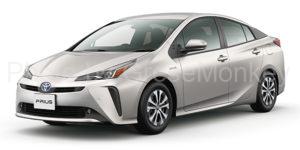
Fuel economy of hybrid cars
A hybrid car uses an internal combustion engine such as a gasoline engine or a diesel engine in combination with an electric motor for power. Hybrid means “hybrid” or “hybrid”. Therefore, a combination other than an engine and a motor may be used, but currently in Japan, a combination of a gasoline engine and a motor is used in passenger cars, and a combination of a diesel engine and a motor is used in trucks and buses.
Therefore, it is not such a simple thing to say that it is enough to combine an engine and a motor as a power source, and there are three main factors that improve the fuel economy of hybrid cars.
- Idling stop
- Brake regeneration
- Driving under optimal engine conditions
Idling stop
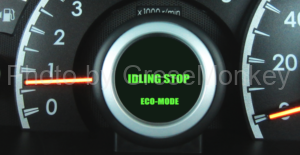
The idling stop is not unique to hybrid cars, but is a technology that can be used with conventional gasoline and diesel engines.
The idling stop is quite effective under driving conditions where the average speed is slow, such as driving in urban areas. In other words, the slow average speed also means that the vehicle remains stationary for a long time. Except for local buses, it is rarely seen in Japan, but there are cases where even domestic cars are used in cars exported to Western countries.
Even in the same hybrid car, this idling stop can be used thoroughly in a system that can be started by a motor like the Prius. This is because the engine is stopped for a long time even when the vehicle is repeatedly started and stopped due to traffic congestion, etc. (The battery needs to be fully charged.)
Also, in the system in which the engine and the motor are directly connected and the engine must always be running when starting (Honda Insight, etc.), the engine must be started each time starting. In this method, there is a problem that the engine will not stop under the condition such as traffic jam where the start and stop of the hampan is repeated. Therefore, we have solved this problem by installing a clutch between the engine and the motor, and by providing a driving mode that allows the vehicle to run only with the motor.
Brake regeneration
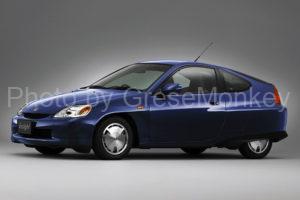
Insight
In a conventional vehicle, when decelerating, the kinetic energy of the vehicle is converted into heat energy by a brake system and released into the atmosphere. Therefore, this kinetic energy is converted into electric energy, stored in a battery, and taken out when necessary for effective use.
That is, it is used as electric power when assisting (assisting) the engine with the motor when a large driving force such as starting or acceleration is required.
Brake regeneration is said to be able to recover about one-fifth of the energy used when accelerating to the speed at the time of control with an ordinary brake that is not a sudden brake.
Brake regeneration also differs depending on the hybrid system. During deceleration, the engine brake also acts in addition to the normal foot brake. Even if the foot brake part is used for brake regeneration to recover the kinetic energy, the engine brake part cannot be recovered.
The Prius can recover all kinetic energy when the engine is stopped, but in the case of Insight, the engine and motor are directly connected, so the engine brake cannot be eliminated.
Therefore, when braking, all valves are stopped from opening and closing to eliminate pumping loss so that there is only pure friction (friction loss and drag resistance) of the engine body. Since the friction of the engine itself also affects fuel consumption, it has been thoroughly reduced.
Without deactivating the valve, the energy recovered during deceleration is about one-third of the kinetic energy. By stopping this valve, drag resistance of the engine (including pumping loss) can be reduced by about 70%, and regenerative energy can be increased to about two-thirds of kinetic energy. (For Honda Insight)
This problem can also be solved by providing a clutch between the engine and the motor and stopping the engine during deceleration.
Motor recovers kinetic energy of car
The reason why kinetic energy can be recovered by a motor is that the principle of power generation is the reverse of the operating principle of a motor. In contrast to Fleming’s left-hand rule, which represents the operating principle of a motor, Fleming’s right-hand rule, which is the target system of the left-hand rule, represents the principle of power generation.
In general, even if the DC motor is operated under no load, it will not rotate more than a certain number of revolutions with respect to the applied voltage. This is because the back electromotive force is generated. When the motor rotates, a counter electromotive force is generated in the coil in a direction that obstructs the direction of the magnetic flux. The direction is the opposite of the current flowing to rotate the motor. This is why it is called back electromotive force.
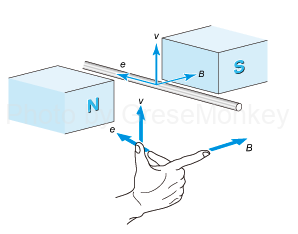
Fleming’s right-hand rule
Since the back electromotive force becomes higher and higher as the rotation speed increases, the current flowing to rotate the motor becomes harder to flow as the rotation speed increases. The rotation speed will not increase.
Therefore, the current to the motor is cut off during braking, and the back electromotive force generated instead is taken out. This is the principle of brake regeneration that makes the motor work as a generator.
However, when the brake regeneration is performed, the problem of what to do with the foot brake occurs. This is because the braking force of the foot brake must be reduced by the amount of the brake regeneration.
Therefore, the foot brake is devised to reduce the braking force of the foot brake by the amount of the brake regeneration. At the same time as reducing the braking force, the brake pedal is required to make a stroke according to the pedaling force. In short, whether the brake regeneration works or not, it is required to generate the braking force by responding to the depression of the brake pedal as in the conventional vehicle. In this regard, a device called a stroke simulator has been devised. (See below)
Driving under optimal engine conditions
For a gasoline engine or a diesel engine, the larger the accelerator opening (the accelerator pedal depression amount, throttle valve opening), the higher the thermal efficiency. That is, the fuel consumption rate becomes small.
This is because the friction (friction loss) of the engine body is not related to the accelerator opening. That is, the friction of the engine body does not change regardless of whether the accelerator opening is increased or decreased. Therefore, under the operating condition where the accelerator opening is small (low load), the same friction as when the accelerator is fully opened is generated although the injected fuel is small, that is, the generated output is small.
Therefore, at the time of low load operation, the ratio of the friction loss due to the consumed fuel increases, and the ratio of the output (output, shaft output) that can be taken out decreases accordingly, so that the thermal efficiency, that is, the fuel consumption rate deteriorates.
In a gasoline engine, the lower the load, the more the pumping loss increases, which is further aggravated.
Also, the friction of the engine body (excluding pumping loss) is roughly proportional to the 1.5th power of the engine speed, so it increases as the speed increases. Therefore, gasoline engine and diesel engine can bring high efficiency by operating at high load and low rotation as much as possible.
If the engine output can be divided into a generator and wheels (driving force) like the Prius, it is possible to operate under operating conditions close to this optimum condition.
With a series hybrid in which the engine and wheels are not connected, but only the generator, it is possible to operate just under these optimum conditions. This is one of the features of the series hybrid.
On the contrary, when the engine and motor are directly connected like Insight, there is almost no room for selecting the operating condition.
Hybrid car method
There are several types of hybrid cars depending on how the engine and the motor/generator are combined, that is, how the driving force is transmitted to the wheels. The main ones are the following three methods.
- Series hybrid
- Parallel hybrid
- Series/parallel hybrid
Series hybrid
The engine turns the generator, and the electric power turns the motor to drive the wheels. In other words, there is no mechanical connection between the engine and the wheels like a propeller shaft, the engine just rotates the generator. Only the motor drives the wheels.
Energy that drives the wheels is a system that flows in series through the elements that make up the system: engine, generator, and motor.
It runs the engine most efficiently to charge the battery and shuts off when it is fully charged.
The engine can be operated in the most efficient area, but since the motor drives the wheels, the motor needs a high output in order to have excellent power performance, and accordingly the battery has a certain large size. Will be needed.
Further, since the output of the engine is converted into electric power all at once, the fuel efficiency during constant-speed traveling during long-distance traveling deteriorates.
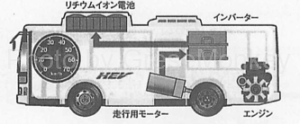
Mitsubishi Aero Non Step HEV
The Mitsubishi Aero non-step HEV in the above figure is an example of using this method, but there are almost no examples in passenger cars. However, it seems that it is being reviewed as a method suitable for a plug-in hybrid car that runs in an EV mode that runs only a motor at a short distance and switches to the engine when the battery level is low.
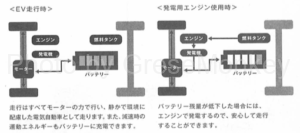
Series method
Examples include GM’s Chevrolet Volt, Premacy Hydrogen RE Hybrid using Mazda’s hydrogen rotary engine, and Suzuki’s Swift plug-in hybrid. The Mitsubishi concept FX/MiEV is also a plug-in hybrid, but when traveling at high speeds, it will be a parallel hybrid that also uses the power of the efficient engine at high speed. Also, for low friction road surfaces, it will be a 4WD system that also uses a rear motor.
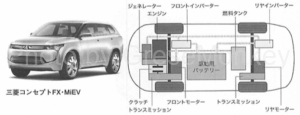
Mitsubishi Concept FX/MiEV
Parallel hybrid
The parallel hybrid also has a mechanical connection between the engine and the wheels, which allows the wheels to be driven by either the engine or the motor. In other words, it is a system in which the engine and the motor are arranged in parallel for driving the wheels.
The parallel hybrid has a simple structure and a low cost, but on the other hand, the effect of the hybrid cannot be fully utilized, so that the improvement in fuel efficiency is somewhat inferior.
In addition to the Mercedes-Benz S400 Blue Hybrid that was put on the market, many European and American manufacturers have been testing it. Among them, in many cases, a clutch is provided between the engine and the motor so that the connection between the two can be disconnected in order to improve the weakness of the parallel hybrid. The Fugue Hybrid sold by Nissan is one of them.
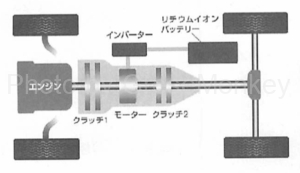
Fugue hybrid operation diagram
Although it is a parallel system, the feature is that a clutch can be installed between the engine and the motor to drive the motor.
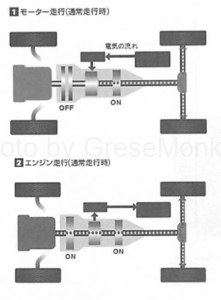

Series/parallel hybrid
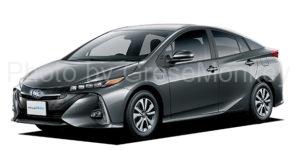
Toyota’s Prius divides the output of the engine into the one that drives the wheels and the one that rotates the generator, and the motor can be rotated by the power generated by the generator. Therefore, the wheels are driven by a combination of the divided engine output and the motor output. In other words, it is a system in which the series hybrid part is added to the parallel hybrid, and is called the series/parallel hybrid.
In this way, since the wheels are driven by the combined force of the engine output and the motor output, high power performance can be provided even with a relatively small engine.
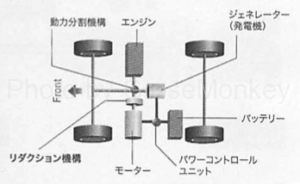
Series parallel method
Since the output of the engine can be distributed by the dividing mechanism at any ratio for traveling and for power generation, it is possible to combine the engine and the motor under optimal conditions according to operating conditions. In addition, it is possible to stop the engine during running or to start and run only by the motor. On highways, the engine is operated at an efficient rotation speed, and the output of the motor is added during acceleration to improve fuel efficiency.
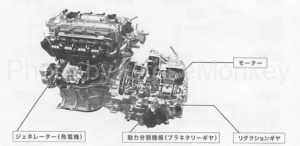
Prius main unit
Although the structure becomes complicated, it can be said that it is a method close to one ideal type as a hybrid. However, complicated control technology is required, and Toyota is the only one that has put this technology into practical use.
Brake control for hybrid cars
When trying to utilize the regenerative brake as much as possible for the purpose of improving fuel economy, it is difficult to configure the brake system. This is because the regenerative brake itself does not have the same generation state as it depends on the state of charge of the battery and the vehicle speed. In addition, the total braking force, including regenerative braking required by the vehicle, varies from gentle braking to sudden braking.
Nevertheless, the driver’s desired braking force is required to be the same as the pedal stroke and pedaling force of a normal car, which does not cause any discomfort regardless of the size of the regenerative brake.
In the case of an ordinary car, the brake pressure (pressure acting on the piston) and the stroke of the brake pedal have a relation. Therefore, it is necessary to realize this even in a hybrid car.
The stroke simulator realizes this braking feeling.
For Honda cars
The operating principle is that when the stroke piston is pushed by the push rod, the rubber stroke damper is crushed, and the required pedal force and stroke relationship can be obtained.
The target brake pressure is a value obtained by subtracting the pressure corresponding to the regenerative brake from the master cylinder pressure before pressure reduction.
Therefore, it is necessary to control the linear solenoid valve so that the master cylinder pressure reaches this target value.
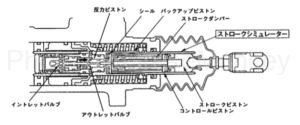
Stroke simulator structure
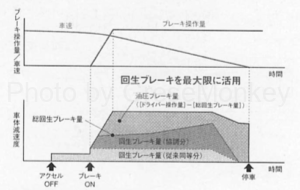
Coordinated control of regenerative brake and hydraulic brake
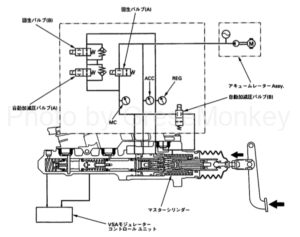
Hydraulic servo brake system
- RGE: The brake operation amount can be known by detecting the pressure regulator pressure.
- ACC: Accumulator pressure can be detected to detect the accumulated pressure.
- MC: Master cylinder pressure is the hydraulic pressure controlled by the servo unit
For Toyota cars
In the case of Toyota vehicles, the operation principle of the stroke simulator is based on the principle of a hydraulic type of accumulator, and when you press the brake pedal, the amount of fluid corresponding to the pedaling force flows into the stroke simulator to realize a natural stroke. ing.
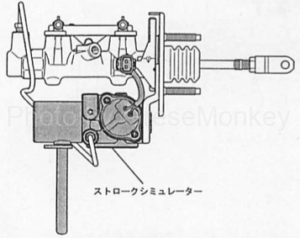
Master cylinder and stroke simulator
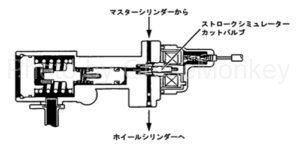
Stroke simulator cross section
In the outline of the brake system shown below, the high pressure generated by the power supply is regulated by the linear solenoid valve and acts on each brake caliper.
The linear solenoid valve is controlled by the cooperative action of the regenerative brake and the hydraulic brake, but the braking force required by the driver, which is the basis of the control, is represented by the operation amount of the brake pedal, and the operation amount is detected by the stroke sensor of the brake pedal. ..
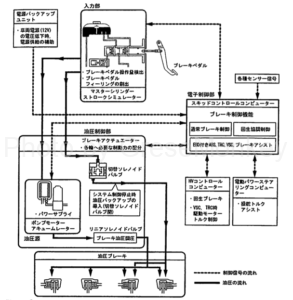
Brake system overview
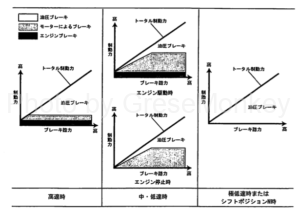
Sharing braking force between regenerative braking and hydraulic braking by cooperative control